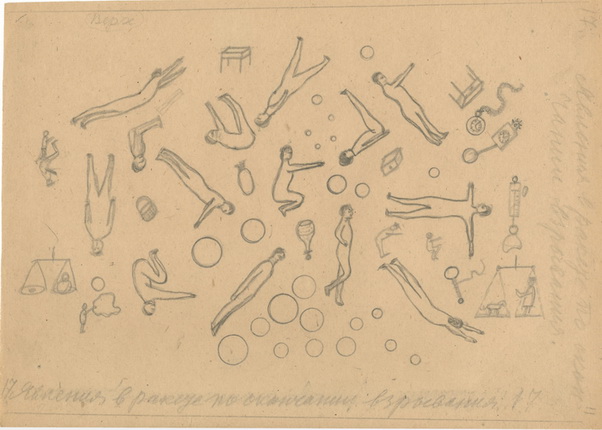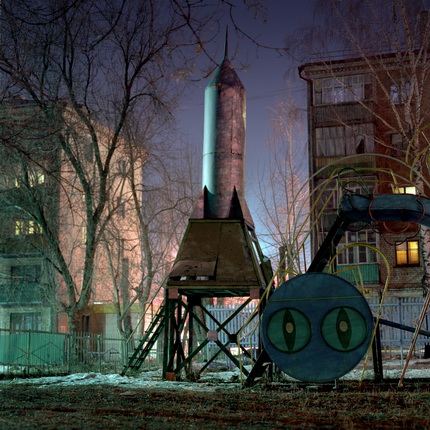Russian Space












Alexander Mokletsov (‘Novosti’ Press Agency). Russian satellite ‘Vostok’. 1960s. Collection of Multimedia Art Museum, Moscow
Valery Gende-Rote. Yuri Gagarin. April 14, 1961. Collection of Multimedia Art Museum, Moscow. © Multimedia Art Museum, Moscow
Konstantin Tsiolkovsky. Album of cosmic voyagers. Article. Manuscript, pencil, drawings, paper. February, 21 1933 Ф.555. Оп.1. Д.84. Л.11. Collection: Russian Academy of Sciences Archive © АРАН
Ivan Mikhailov. From the ‘Playground’ series. 2010. Collection of Multimedia Art Museum, Moscow. © Ivan Mikhailov
Ivan Mikhailov. From the ‘Playground’ series. 2010. Collection of Multimedia Art Museum, Moscow. © Ivan Mikhailov
Ilya and Emilia Kabakovs. Center of Cosmic Energy. Exterior of the central building (building No. 1). No. 7. – Portfolio. Mike Karstens Graphics Editions, 2003. Collection of Multimedia Art Museum, Moscow. © Ilya and Emilia Kabakovs
Ilya and Emilia Kabakovs. Center of Cosmic Energy. General view of the Center of Cosmic Energy No 3. – Portfolio. Mike Karstens Graphics Editions, 2003. Collection of Multimedia Art Museum, Moscow. © Ilya and Emilia Kabakovs
Moscow, 18.05.2016—18.09.2016
exhibition is over
Share with friends
Curator: Olga Sviblova
Chief project coordinator: Olga Nestertseva
The exhibition project marks the 55th anniversary of man’s first space flight
Participants in the project: RSC Energia, Russian Academy of Sciences Archive, K.E. Tsiolkovsky State Museum of the History of Cosmonautics, Kazan National Research Technical University named after A. N. Tupolev-KAI, Moscow Museum of Modern Art, Museum of Moscow, N.F. Fedorov Museum — Library, Triumph Gallery, Regina Gallery, Krokin Gallery, Gazprombank, Sepherot Foundation, Switzerland, Stellа Art Foundation, Moscow, Private collections, Russia
For the press
The ‘Russian Space’ exhibition project marks the 55th anniversary of man’s first space flight. This is an attempt to analyse how the concept of space as conceived by Russian philosophers, scientists, writers and artists in the early 20th century relates to Russian contemporary art.
Vast geographical territory, harsh climatic conditions and the Russian people’s tendency from time immemorial to dream and hold religious beliefs about a future paradise, regardless of actual living conditions, provided the philosophical prerequisites in Russia for ideas of the cosmos and the dream of conquering space. The religious philosopher Nikolai Fyodorov (1829-1903) first developed the notion of cosmism. At the heart of his theory lay the thesis of united scientific and practical labour by all inhabitants of the Earth to enable the physical resurrection of departed ancestors, as well as the further settlement of resurrected and presently existing human beings in cosmic space. Fyodorov’s philosophical ideas were furthered by his pupil, the great Russian scientist Konstantin Tsiolkovsky (1857-1935) who laid the scientific foundations for the future era of cosmonautics. At the same time Tsiolkovsky developed a concept of the radiant transformation of mankind, thus giving them the chance to become immortal and discover the endless possibilities of cosmic space travel.
In Russia ideas of the future have always predominated over any understanding of the present. At the beginning of the 20th century they became a source of inspiration for Russian avant-garde writers and artists: the poet Velimir Khlebnikov, artists Alexander Rodchenko, Vladimir Tatlin, Ilya Chashnik, Vladimir Sterligov, Nikolai Suetin, and others. In general the aesthetics of the Russian avant-garde were an attempt at visual realisation of the progression towards a radiant future, related not so much to the transformation of reality as to mastery of the limitless cosmic space. The technological manifestation of these utopias were the designs by Russian constructor Sergei Korolyov (1907-1966), resulting in the world’s first launch of a space satellite from the USSR and man’s first space flight. After the 1917 October Revolution the new Soviet powers at first showed active support for the Russian avant-garde and for scientific research, inspired by ideas of transforming the future. But by the 1930s the onset of totalitarianism led to confrontation between avant-garde ideas and a totalitarian ideological system. Russian avant-garde artists became superfluous in a time of regime-imposed socialist realism, and scientists including Korolyov were subject to Stalinist political repression. The Soviet Union had won the war but also fallen behind in terms of technological development, so every effort was made to gain ground in the postwar period. The USSR set previously repressed scientists back to work and revived ideas of conquering space, as an ideological and not only technological myth. In 1957 the myth became reality with the launch of the first space satellite by the USSR. Then, in 1961, the Soviet Union and mankind as a whole were thrilled to hear the news of man’s first entry into space.
This ‘Russian Space’ project unites in one exhibition space the work of artists of the Russian avant-garde and scientists such as Konstantin Tsiolkovsky with that of Russian artists from the Khrushchev Thaw until the present day. We see here the plastic system of the Russian avant-garde, yet the very idea of reconstructing the world is subject to revision, even in connection with the Project for its overall improvement. This is the post-totalitarian reflection of a generation that coincided with Khrushchev’s criticism of Stalinist totalitarian ideas. As a result we see the work of Francisco Infante, showing the dualism of a romantic yet ironic response to the Suprematist ideas of his precursors, the artists of the early 20th-century.
Cosmism is the only Soviet myth actively propagated in the Soviet Union from the mid-1920s onwards to have retained its impetus to this day. This myth with its heroic principle allowed the formation of heroic ideals for several generations of Soviet children. Hence for several decades the children’s playgrounds in Soviet courtyards were furnished with rockets and other attributes on a space theme, stimulating the dream that they too might one day become cosmonauts. The young photographer Ivan Mikhailov captured these romantic aspirations in his series ‘Playground 2010’. Galactic holes became the subject of drawings by one of the leaders of Russian contemporary art, Pavel Pepperstein, in his series ‘Cosmic Holes’ (2011). Gurus of international and Russian contemporary art Ilya and Emilia Kabakov created their own version of cosmic mythology with the series ‘Centre of Cosmic Energy’ (2003). This oeuvre seems to offer a direct dialogue with Konstantin Tsiolkovsky’s sketches from ‘Album of Space Travel’ (1933), drawn for the cult film ‘Space Flight’ (1935), which became a major source of inspiration not only for Soviet people, but also for Kubrick and Lucas. Apart from Tsiolkovsky’s drawings, we will be displaying his model for a spaceship and the cylinder ‘for listening to the music of the spheres’ from the Tsiolkovsky Museum in Kaluga. Works by Konstantin Batynkov from the ‘Cosmos’ series (2011) continue the dialogue with Fyodorov’s ideas on facilitating the human colonisation of space. The central exhibit will be Vostok-1, Y.A. Gagarin’s re-entry capsule, which will leave the Energia Rocket and Space Corporation Museum specially for this exhibition.
The space myth also survived the epoch that brought the total demythologisation of Soviet myths during Gorbachev’s perestroika in the late 1980s. The myth became a source of inspiration for new artists from St. Petersburg: Timur Novikov, the ASSA group (Timur Novikov, Georgy Ostretsov, Ivan Sotnikov, Oleg Kotelnikov), and also Andrei Krysanov, Ilya Kitup, Igor Verichev (New Composers group), Dmitri Gutov, and others. The cosmic myth withstood the breakup of the Soviet Union in 1991. In an ironic or romantic interpretation this myth continues to develop even today, in the work of Sergei Shutov, the Blue Noses group, Margo Trushina, etc.
Today, in an epoch of total demythologisation, the myth of space still remains as a source of vital energy and gives hope for an exit from the present global crisis afflicting our world.
Participants in the project:
RSC Energia
Russian Academy of Sciences Archive
K.E. Tsiolkovsky State Museum of the History of Cosmonautics
Kazan National Research Technical University named after A. N. Tupolev-KAI
Moscow Museum of Modern Art
Museum of Moscow
N.F. Fedorov Museum — Library
Triumph Gallery
Regina Gallery
Krokin Gallery
Gazprombank
Sepherot Foundation, Switzerland
Stellа Art Foundation, Moscow
Private collections, Russia
Sponsor
General radio partners |
Strategic information partners |
Special media partner
Information partners










